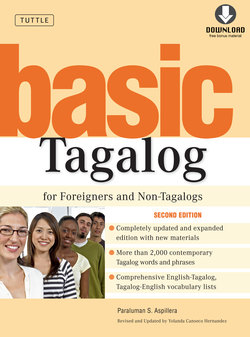Читать книгу Basic Tagalog for Foreigners and Non-Tagalogs - Paraluman S. Aspillera - Страница 13
На сайте Литреса книга снята с продажи.
ОглавлениеLESSON FOUR
The Articles Si and Ang
Any noun that is used as the subject of a sentence—including names of persons, places, and things— is always preceded by an article, except in direct conversation and in imperative statements.
I. THE ARTICLES SI AND SINÁ
The singular article si is used before the name of a person and the plural article siná is used before the names of two or more persons.
| Si Ruth ay babáe. | Ruth is a woman. |
| Si Peter ay laláki. | Peter is a man. |
| Si Helen ay batáng babáe. | Helen is a young girl. |
| Si Tom ay batáng laláki. | Tom is a young boy. |
| Si Ruth ay magandá. | Ruth is pretty. |
| Si Peter ay marúnong. | Peter is intelligent. |
| Sina Helen at Tom ay mababaít. | Helen and Tom are good. |
| Sina Helen at Tom ay mga batà. | Helen and Tom are children. |
Note that Tagalog sentences follow a plurality rule where either the subject or predicate may be made plural. However, the pluralization of both subject and predicate is optional. In the last sentence above, the article sina indicates that the subject is plural while mga (a plural marker that has no meaning on its own) before batà indicates that the noun is plural. Adjectives form their plural by duplicating the first syllable of the root word. For example, mabaít (or kind, root word is baít) becomes mababaít.
II. THE ARTICLES ANG AND ANG MGA
The article ang is used before the name of a single thing or place while ang mga (pronounced manga) is used before the names of two or more things or places.
